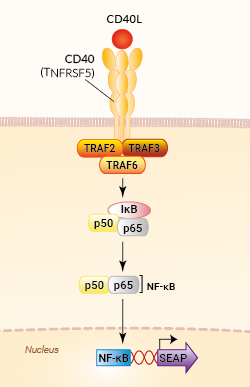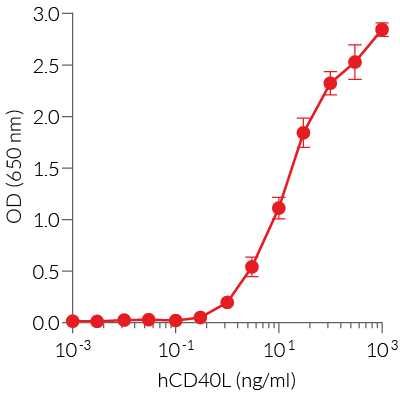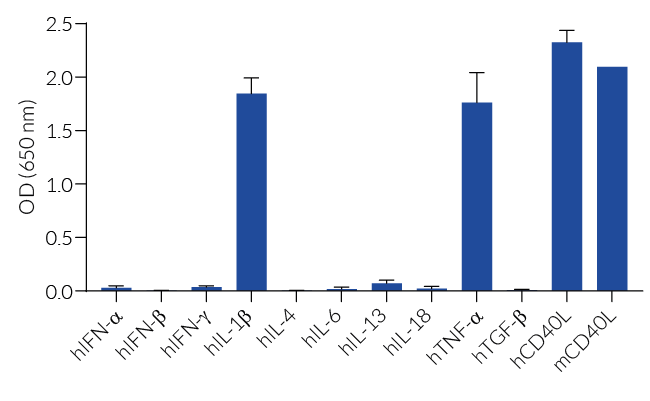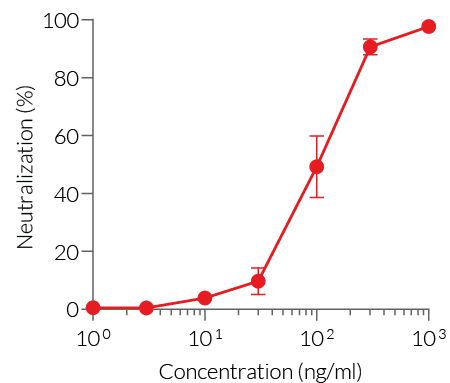CD40L Reporter HEK 293 Cells
| Product | Unit size | Cat. code | Docs. | Qty. | Price | |
|---|---|---|---|---|---|---|
|
HEK-Blue™ CD40L Cells Human CD40L SEAP Reporter Cells |
Show product |
3-7 x 10e6 cells |
hkb-cd40
|
|
||
|
HEK-Blue™ CD40L vial Additional cell vial |
Show product |
3-7 x 10e6 cells |
hkb-cd40-av
|
Notification: Reference #hkb-cd40-av can only be ordered together with reference #hkb-cd40.
CD40L responsive NF-κB-SEAP reporter assay

Signaling pathway in HEK-Blue™ CD40L cells
HEK-Blue™ CD40L cells are designed to monitor human CD40L-induced NF-κB stimulation or inhibition. This colorimetric bioassay can be used to screen activatory or inhibitory molecules, such as engineered cytokines and neutralizing antibodies, respectively.
HEK-Blue™ CD40L cells respond specifically to recombinant human CD40L and mouse CD40L. Their reliable and consistent performance makes them suitable for release assays of activatory and inhibitory molecules such as Frexalimab, a monoclonal antibody that targets CD40L and prevents its binding to its receptor (see figures).
Key features
- Readily assessable NF-κB-SEAP reporter activity
- Convenient readout using QUANTI-Blue™ Solution
- High sensitivity to human (h)CD40L and mouse (m)CD40L
- Stability guaranteed for 20 passages
Applications
- Therapeutic development
- Drug screening
- Release assay
CD40L is a protein that is primarily expressed on activated T cells and is a member of the tumor necrosis factor superfamily. Of note, CD40L, together with its receptor CD40, plays a pivotal role in cellular and humoral immunity.
InvivoGen’s products are for research use only, and not for clinical or veterinary use.
Back to the topSpecifications
Cell type: Epithelial
Tissue origin: Human Embryonic Kidney
Target: CD40L
Specificity: Human, Mouse
Reporter gene: SEAP
Antibiotic resistance: Blasticidin, Zeocin®
Detection range: 3 ng/ml - 1 µg/ml (hCD40L and mCD40L)
Growth medium: Complete DMEM (see TDS)
Growth properties: Adherent
Mycoplasma-free: Verified using Plasmotest™
Quality control: Each lot is functionally tested and validated.
Back to the topContents
- 1 vial containing 3-7 x 106 cells
- 1 ml of Blasticidin (10 mg/ml)
- 1 ml of Zeocin® (100 mg/ml)
- 1 ml Normocin™ (50 mg/ml)
- 1 ml of QB reagent and 1 ml of QB buffer (sufficient to prepare 100 ml of QUANTI-Blue™ Solution, a SEAP detection reagent)
![]() Shipped on dry ice (Europe, USA, Canada)
Shipped on dry ice (Europe, USA, Canada)
Details
CD40 Ligand (CD40L), also known as CD154, TRAP, or gp39, is a type II transmembrane glycoprotein belonging to the tumor necrosis factor (TNF) family. It is mainly expressed in CD4+-T cells and interacts with CD40 on antigen-presenting cells to regulate both humoral and cellular immune responses [1-3].
The CD40 cytoplasmic domain binds directly to several TNF receptor-associated factors (TRAFs), and this interaction is thought to initiate CD40 signaling. CD40-mediated signaling results in NF-κB, c-Jun N-terminal kinase (JNK), and p38 mitogen-activated protein kinase (MAPK) activation. CD40L-CD40 interactions are thought to play an important role in the pathogenesis of many diseases [4, 5].
1. Karnell J.L. et al., 2019. Targeting the CD40-CD40L pathway in autoimmune diseases: Humoral immunity and beyond. Adv Drug Deliv Rev. 141:92-103.
2. Laman J.D. et al., 2017. Functions of CD40 and Its Ligand, gp39 (CD40L). Crit Rev Immunol. 37(2-6):371-420.
3. Elgueta R. et al., 2009. Molecular mechanism and function of CD40/CD40L engagement in the immune system. Immunol. Rev. 229, 152–172.
4. Seijkens T. et al., 2013. CD40–CD40L: Linking pancreatic, adipose tissue and vascular inflammation in type 2 diabetes and its complications. Diabetes and Vascular Disease Research. 10: 115 - 122.
5. Daoussis D. et al., 2004. Targeting CD40L: a promising therapeutic approach. Clin Diagn Lab Immunol. 11(4):635-41.










